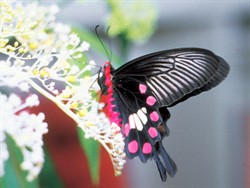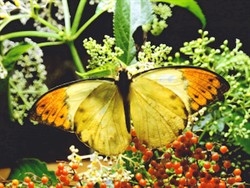Tour Highlights

Pachliopta aristolochiae interpositus butterfly
With Yangmingshan National Park the altitude ranges from 200 meters to 1,120 meters above sea level. The plant communities have very varied morphology and distributions. The complex and varied environment naturally gave birth to many plant species upon which butterflies now inhabit, feed, and reproduce. According to the tally, there are approximately 150 species of butterflies in the Yangmingshan area, among which about 100 species are stable populations that appear annually. Common among the denser shade of forest trails are the shade-loving satyrines (browns) and nymphalidaes (four-footed butterflies). Swallowtails, pieridaes, milkweeds and lycaenidae (gossamer-winged butterflies) are more commonly seen on the parts of the trail with more sunlight and may appear right next to the visitor.
Every year in the summer from early May to early July, huge numbers of chestnut tiger and Parantica swinhoei butterflies appear in groups. On sunny and windless mornings, they will spread throughout the Mt. Datun area and, starting and stopping among the Shimadai Agrimony (Eupatorium shimadai Kitam), as they slowly make their way up the mountain. Sometimes there will be thousands of chestnut tiger butterflies on just one 100 to 200 meter stretch of path of Shimadai Agrimony, painting a spectacular picture of a sea of butterflies dancing among the flowers. The best time for viewing butterflies is in the morning when the weather is fair and the air is calm. Butterflies will gradually disperse and disappear after noon.
In addition to the sight of butterflies in the mountains, the wide varieties of chirping insects are also integral parts of the Yangmingshan summer. In addition to the deafening cry of cicadas, there is the low, resonating notes made by katydids (long-horned grasshoppers), crickets, and other insects. Together, they compose a symphony of movement.
Suggested Itinerary
- Taipei → Bailaka Highway → Erziping Visitor Center (Entrance of the Mt. Datun car lane) → Erziping Trail (1.7km, accessible trail)→ Erziping → (1.7km) Datun Nature Park → Erziping Visitor Center

Orange-tipped butterfly
Feature
The entire trail is 3.4 km long. The Erziping trail is approximately 3 m wide. The road is flat and gentle; the forest is on either side and the trail is not exposed to much direct sunshine.The trail is cool in the summer and is sheltered from strong winds in the winter.The trail is suitable for hiking throughout the year.Many plant and animal species live along this trail. It was once known as the ’butterfly corridor’, but because the growth of trees blocked out the sun, the Eupatorium shimadai died out, which later resulted in a decrease in the number of chestnut tiger butterflies.However, there are still large numbers of orange oakleaf, browns, brush-footed butterflies, and gossamer-winged butterflies. If you want to travel through the butterfly kingdom, we recommend that you visit during summertime.
Getting There
- From Taipei Main Station, take the Metropolitan Transport Corporation (MTC) bus 260, or the MTC bus R5 from the MRT Jiantan station, and transfer to the Park Bus 108 at the Yangmingshan Main Terminal and alight at the Erziping stop.
- On holidays and weekends visitors can take the San-Chung bus 111 from Xinzhuang or the MTC bus 109 from the Wanfang community and alight at the Yangmingshan stop; then proceed to take the park bus 108 from the Yangmingshan Main Bus Terminal and alight at the Erziping stop.
Return Trip
From the Erziping stop, take the 108 park bus to the Yangmingshan Main Bus Terminal and transfer to MTC R5 or 260 bus to return to Shilin, Jiantan, or Taipei Main Station.On holidays and weekends, take the San-Chung bus 111 from Yangjin Highway or Shengli Road to return to Xinzhuang, or the MTC bus 109 to return to the Wanfang community.